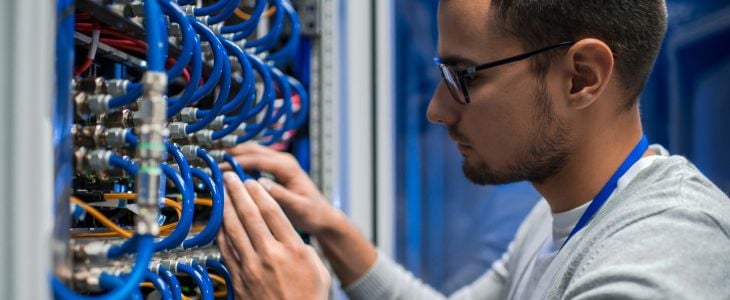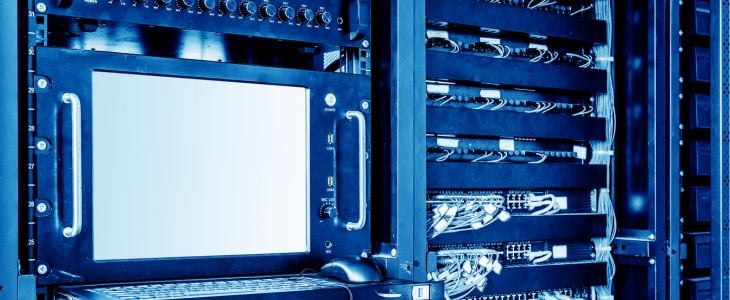Two-phase immersion cooling represents a promising and exciting technology for server cooling.
As workloads increase their density and so does equipment’s ensuing heat, server operators are faced with an urgent need to optimize their efficiency. This has put a renewed focus on cooling technologies, with the aim of achieving optimized energy consumption while guaranteeing reliable service for technological operators.
Let’s take a look at server room cooling and how two-phase immersion cooling methods are revolutionizing their possibilities.
A beginners guide to server room cooling
Understanding and optimizing server room cooling is not a trivial endeavor, as the cooling system of most data centers accounts for between 30 % to 50 % of energy consumption. As such, implementing efficient cooling systems has remained a top priority to save energy.
These are the key current possibilities:
- Air-cooling solutions: these use air as a medium to dissipate heat generated by servers. Through a combination of air conditioning units, fans, and ventilation systems, they’re able to circulate cool air throughout the data center while also exhausting warm air from the IT equipment.
- Liquid cooling systems: in this case, a liquid coolant is used to cool servers by absorbing heat while circulating in a closed-loop configuration. Depending on whether the cooling medium is in touch with the electronic equipment or not, there are two categories within liquid cooling: cold plate cooling and immersion liquid cooling. Immersion cooling relies on putting immersion cooling fluid in direct contact with electronic equipment, which absorbs the heat source by convection and releases it into the environment. As we’ll see below, this can be done either as a single-phase or a two-phase immersion cooling system.
As for the pros and cons of CRAC units and liquid cooling solutions, these are some of the most significant:
- Liquid cooling is generally more efficient because liquids present a higher heat transfer coefficient, that is, they’re better at removing heat from electronic components.
- Liquid cooling systems can handle higher heat loads, thus are protagonists in complex operations such as high-density computer applications.
- Air cooling systems are generally easier to maintain and require less upkeep operations, while their installation is usually more costly and complex, needing server-grade piping and additional equipment such as fans and ventilation units.
- When it comes to operational costs, the simplicity of liquid immersion cooling systems leads to lower power consumption as well as overall operational costs. In fact, research has found two-phase immersion cooling is particularly cost-efficient in hot and high-humidity areas and to be cheaper on a fixed capital investment.
- Liquid cooling systems present a more directional way of cooling hot components.

Two-phase immersion cooling: a definition
Two-phase immersion cooling is a liquid immersion method for cooling servers and other electronic devices that works by submerging them in a non-conductive liquid that boils at a low temperature, typically a fluorocarbon-based fluid.
The cycle works like this:
- When electronic devices are immersed in the liquid, the heat generated by their components causes the liquid to boil, generating vapor.
- This vapor then rises to the top of a tank, effectively carrying away heat from the electronic components.
- The next step is the vapor condensing back into liquid form when in contact with a cooling surface (for instance, a heat exchanger or cooling coil).
- It is then pumped back into the immersion tank, completing the cooling cycle.
This two-phase immersion cooling represents a more efficient approach when compared with traditional air or liquid cooling methods. This is because it provides more direct contact between the cooling medium and the heat-generating components. As such, it results in faster heat transfer and better temperature control. It’s also worth mentioning that it also eliminates the need for fans and other mechanical components that can introduce noise and vibration into the data center environment.
Two-phase immersion cooling vs. single immersion cooling
- Single-phase immersion cooling operates by circulating an immersion cooling fluid without any phase phenomena. That means electronic components are immersed in a dielectric cooler. In the case of server cooling, the server is installed vertically in a dielectric liquid cooling bath that is thermally conductive. The liquid is in direct contact with server components, and cooled via a heat exchanger. It then discharges the collected heat to the ambient through the cooling tower. As such, there is no boiling process involved.
- Two-phase immersion cooling also involves immersing server components in an immersion cooling fluid within a closed box or other adequate environment. However, it varies from the process described above in that the liquid gets boiled and becomes steam, to then follow the process we’ve described above.
As such, the main difference between two-phase immersion cooling and conventional, single-phase immersion cooling is the state of the cooling fluid. In single immersion cooling, the fluid absorbs heat generated by components but remains in a liquid state. This heat is then dissipated through convection and conduction.
On the other hand, two-phase immersion cooling means the cooling fluid is in a two-phase state, existing both in its liquid and vapor form.

The enhanced efficiency of two-phase immersion cooling
The two-phase immersion cooling approach provides a more efficient and effective cooling solution than single-phase immersion cooling. The reason is it allows for faster and more direct heat transfer from the electronic components to the cooling fluid.
This is thanks to the boiling of the fluid on the surface of the components, which provides an efficient heat transfer mechanism that can quickly remove heat from high-power components. This eliminates the need for any intermediate heat exchangers or cooling systems. As an additional benefit, it guarantees a high thermal conductivity that translates into heat being transferred away from servers in a quick manner, facilitating a better temperature control and performance.
This represents a particularly promising technology in the face of increasingly high-density workloads associated with AI and machine learning applications, compared to normal immersion cooling.
When looking at pPUE (partial Power Usage Effectiveness), research has shown two-phase immersion cooling provides better temperature uniformity compared with single-phase immersion cooling. At the same time, additional research has shown the Coefficient of Performance of a two-phase immersion cooling system to be between 72 and 79 % higher than that of a single-phase cooling system in the power range of 6.6 ∼ 15.9 kW.
All in all, two-phase immersion cooling is being hailed as a solution to develop energy-efficient and sustainable server cooling in the face of increasingly demanding equipment.
At ARANER, we help companies develop innovative cooling solutions for IT equipment, including server and data center cooling. Get in touch with us and find out how we can help you.










